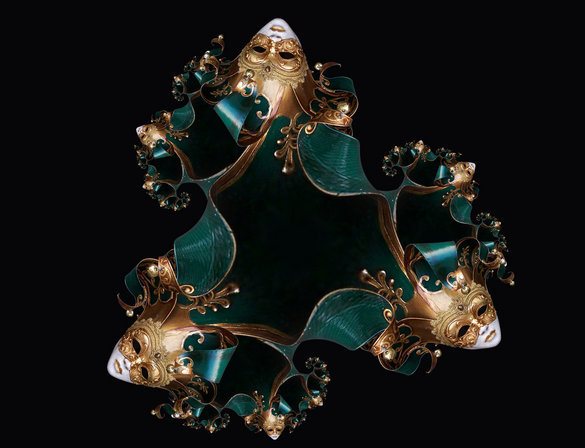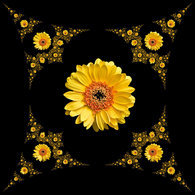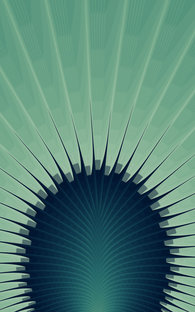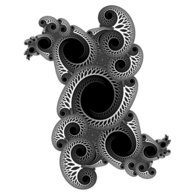Fractal Explorer Pixel Bender Plugin
Published on 14 July 2009
A new Pixel Bender plugin for generating a wide variety of fractals in real-time. A key feature enables images to be mapped into fractal space creating some amazing results.
Head over to the Fractal Explorer project page to download the plugin and find out more.

The above image is licensed under the Creative Commons Share Alike-Attribution-Non-Commercial license as per the original thanks to Audringje.
Last updated: 14 July 2009
23 Comments
Older: Fractals and generative art resources Newer: Artforms of Nature
Links & further reading
Related posts
- Introducing Frax
- The project I've been working on for the last two years...
- A Series of Snowflakes
- A selection of subverted seasonal snowflakes
- L'Eclaireur
- A series of looping animations from an installation at L'Eclaireur in Paris.
- Music Box
- A journey into a Fabergé inspired world.
- More blog posts



That's a pretty incredible piece of work but I couldn't get it to output as a .pbj file from Pixel Bender. How did you get it to work in Flash?
Thanks Joc. Unfortunately at the moment Flash doesn't support loops in Pixel Bender filters, which is a fundamental requirement for fractal generation, so you can only use them in the PB Toolkit, Photoshop or AfterEffects CS4.
Amazing Tom!
Fantastic work. It´s so easy spending a lot of time exploring fractals...
absolutely sweet!
thank you SO much for sharing :)
No problem Tom,
wouldn't want to take away from the fact that it's a really nice filter and a generous gift to the community. In the Fractal Explorer pdf it mentions Flash CS4, does this mean you use it as a compile time filter? (I haven't moved to CS4 yet)
great piece of code !
the fractalExplorer keeps telling me that "the kernel is too complex for my graphics card" :/ fortunately the OrbitTraps work fine :)
it's very interesting to play around with the settings
thanks a lot for sharing :)
Nicoptere, you should check the Pixel Bender forums on adobe.com to see what the support for the different graphics cards there is. I certainly haven't seen that issue on my iMac.
How did you do the balls on:
http://www.visualcomplexity.com/vc/project_details.cfm?id=680&index=680&domain=
Thanks for the filters. Of course I want more -- how about The Guilloché Pattern Generator as a Pixel Bender filter?!
Rich, the Guilloche patterns wouldn't work in Pixel Bender as they are generated via vector curves. The nature of a Pixel Bender kernel is an operation that is applied to a single pixel independently of any of the other pixels. Many pixels are calculated in parallel, which is why they can be so fast. Something like a Guilloche pattern generation traces a path over many pixels in a linear manner so each pixel can't be calculated independently in parallel.
The balls image was created with Structure Synth: http://structuresynth.sourceforge.net/ and rendered with Sunflow: http://sunflow.sourceforge.net/
Its Great i will try it..... Thanks. :)
Thank you for highlighting this wonderful tool as well as creating the project page for all to use.
Regards,
Manny
Many thanks, this is wonderful! I am attempting a port to Quartz Composer. Ill let you know if I get anything working :)
Thanks Vade. I've been following your stuff for a while and intended to see what Quartz Composer could do with something like this so I'll be interested to find out how you get on.
Thanks! I really have been enjoying seeing your explorations of this. I Really like what this can do, and think it is totally worth porting to QC. I took some short cuts and found the auto-generated GLSL that pixel-bender creates to run on the GPU, so ive been trying to use that as a basis for the plugin. Unfortunately the code is mangled from your pixel bender original source due to code automation tools general poor legibility.
I was pondering making it a custom plugin, but am having some issues as QC assumes rectangular texture coordinates vs what appears to be assumptions of 2D (0/1 normalized coords) in pixel bender. I have the shader running and outputting an image, but its clearly not what it should be. I dont understand the algorithm (my math sucks), so If you want to help out with the port or see what I have, ping me at vade [at] vade [dot] info.
Again awesome work!
Congratulations on getting your plugin released - very impressive - and the PDF guide and example pictures are very good (I love the Haeckel ones).
Unfortunately it only runs on the CPU for me - so no real-time explorations here :-(
How fast does it run on the GPU - several frames per seconds?
Btw, I bought the Pickover book a couple of weeks ago (it's cheap used on Amazon), and have been playing around with some of his systems myself. I even considered writing a small app for visualizing orbits for generic mathematical expressions, but I'm not sure that I can find the time.
Thanks Mikael.
On my GPU in Photoshop the plugin runs fast enough on a 2k square image for pretty smooth realtime tweaking in my 2008 iMac (I don't have the gfx card specs at hand just now). Cranking the antialiasing up to 3 (so 9 samples per pixel) it takes about a second to render the final output.
Ah. Sometimes the Pixel Blender Toolkit is not able to detect my GPU, but other times it is. E.g. if an instance of Pixel Blender Toolkit is already running, any new instances will fail to detect the GPU and fallback to the CPU.
So I managed to get the plugin running on my laptop with a Nvidia 8400M GS GPU (which is unsupported according to Adobe). VGA output runs smoothly at 100+ FPS.
Incredible so much faster the GPU acceleration makes it.
Hi, the program is so fun! Just wondering if it is possible to add multiple images at once into the PBT??
Carly: at the moment it isn't possible to use two source images (I'm not sure how that would work with Photoshop either). I have been thinking about possibly adding a feature to enable the source image to be split into quarters, stay tuned for that :)
Simply Fantastic! :D
This reminds me of the WMPhoto program which uses a similar method to take images and warp them into fractal designs very similar to Fractal Explorer... although not with as much detail and rendering quality.
Can this program render fractal-warped images over image backgrounds? In other words, can I import an image so that I can render a fractal over it... like a layer or object?
Superb plugin Tom. Your User guide was very useful to explore options of it.
Thanks for the plug in tom! I love all the plug-ins you come up with - don't ever stop - I did wonder actually, have you finished the mandelbox plug in yet?
teamfresh